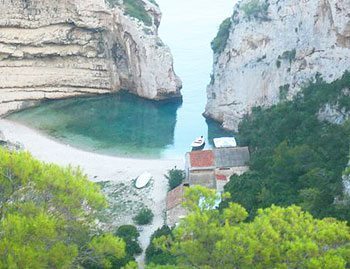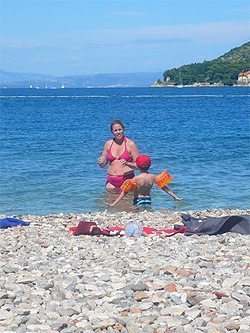By Wynne Crombie

This time nothing but a Land Rover would do to explore the interior of Vis, an island off the Dalmatian Coast.
Kept off-limits to the world by the military under former Yugoslavian dictator Josip Tito, its lack of commercial development has kept it in a fairly pristine condition. But that is about to change.
At the end of our journey lay the village (all ten dwellings of it) of Jujeca. For at least 450 years, this tiny enclave has been home to my family, the Zitkos. Now, my husband and I were about to meet some of them.
Paraglider Guide
Our guide was Jurica Zitko, a community leader, paragliding instructor and distant cousin. Jurica and Dimar, our driver, took us to what they referred to as sights untouched by tourists.
Jurica began by reciting all the conquerors of Vis throughout the centuries: Turks, Italians, Greeks, Serbs… even the British. Now it’s back to being Croatian. The vestiges of each culture, he added, are the reasons Vis is so appealing.
As our Land Rover, climbed the hills above Vis Town, we had a perfect view of Cold War bunkers nestled in several coves.
Tito had used the island as a base for coordinating partisan military operations. Prior to that, the exiled Yugoslav government and the Allies used caves on the island as World War II bases.
Today, the simple sign, “Tito’s Cave” at the entrance, announces his former presence. About two hundred steps bring you to Tito’s meeting rooms; another hundred will take you to his living quarters. Now, all we saw of past military occupation were a few strands of barbed wire, bent over by winds and neglect.
As we rolled along off the main highway, (two 2-lane highways bisect Vis, connecting Vis town with Komiza), the road became decidedly bleaker
At one point, the Land Rover was pushing four-foot weeds out of our path. At the end, amidst wild thyme, rosemary and sage was a missile launcher site left over from the Cold War..and a scrumptious panorama of the island
Fort St. George
Dimar brought the Land Rover to a halt amidst pine trees and crumbling walls. No signs announced the remains of Fort St. George, built by the British in 1813 to guard the harbor. After vanquishing Napoleon in 1815, they abandoned the Fort to the elements.
Parts of it have crumbled, but most of it, including walls and cannons, are still intact. We were the only people there. It seems commercialization has not yet taken hold.
Our attention then turned to the center of the island. Now it is all vineyards, but during World War II, the British used it as an airfield. The pillars with red and white stripes that used to mark the runway can still be seen.

Julicka had inserted a stop at a local winery… a must he said. Marco Hrga, the owner, walked us through the process from grapes to bottles. Of course, nothing would do but a few samplings.
Wine production was halted during the communist era and vines allowed to ruin. Now, there is great pride in new vineyards and wine is once more being produced.
And, just like Fort St. George, the remains of a 7th-century church (St. Mary’s) were without identification or visitors. Only the pines kept it company. Next to it stood an abandoned farmhouse, formerly occupied by the Allies.
Tiny Island Villages
The inland villages are very tiny… stone houses with red tile roofs surrounded by vineyards, olive trees, and cattle. The vines wind around the hillside and over stone walls. It is totally unspoiled.
Life revolves around wine, olive harvests, fishing, and local festivals. Wild herbs, such as thyme, rosemary, and lavender are hardy perennials.
As the sun was setting, we reached Jujeca; a walking path took us the last few hundred yards. Julika was our interpreter when Antonio Zitko, age 87 said, “We are humbled you came all the way from America to visit us.” It was the end to a perfect day.
The next day, it was time to explore on foot. We couldn’t miss strolling over to the fifteenth century Franciscan Monastery on the narrow peninsula, Prirovo.

My grandparents had been married in the church while great grandparents were buried in the surrounding churchyard.
Walking among the gravesites is stepping through centuries. Communist stars on some graves showed that the old government still owns some property.
The locked and gated British cemetery in Kut is the final resting place for sailors who perished during a War of 1812 battle. The adjacent Archaeological Museum of Vis has incredible collections of two-thousand-year-old Greek and Roman artifacts.
Our headquarters, the San Giorgio Hotel in Kut, was a twenty-minute walk from Vis Town. It was in July. Yachts pulled up and its occupants dined al fresco on the decks. Tourists can have their pick… sailing,
snorkeling and swimming. Not to mention exploring nearby coves and caves.
Sunken ships from the 1866 War are a great draw, also, subs and an airplane or two. Incredibly, the water is so blue, you can almost see to the bottom. All the beaches are rocky, but no one seems to mind.
Croatian Medical Care

We had first-hand experience with Croatian medical care. My husband had an attack of pancreatitis. The staff at the San Giorgio quickly mobilized. Dr. Doraevic (in scrubs) arrived in twenty minutes accompanied by his nurse.
They took him over to the clinic in town where he was hooked up to an IV containing anti-spasmodic and pain drugs were given.
The total bill came to $100. Remarkable, especially since we hadn’t paid into their system. Oh, Dr. Doraevic also prescribed lots of Caj Menta (mint tea) and rice. The seniors here all seemed so….vital.
Yet smoking, drinking and sun exposure were so prevalent. When I asked about it, several locals told me the same thing. People do a lot of physical work and eat only what they need.
In addition, generations of one family live together to provide emotional support.A new twenty-four room hotel is being planned for Vis Town. Right now, Vis is unspoiled, but how long can it last?

Practical Information about Traveling to Vis: Croatia Airlines flies from most major European cities to Split. From Split, there are frequent ferries to all the Croatian islands. Ferry from Split $7/one way (4.7 euro)
Hydrofoil $16 one way (11 euro)We hired Dimar and the San Giorgio’s Range Rover for about $70/day. Jurica Zitko, a relative, came at no charge. Rental cars are available through the Ionios Agency in Vis Town (011-385-21-711-352)
Croatian is the island’s language, but English, Italian and German are widely spoken.
Eating in Vis
Vis cuisine is based on seafood. Here are three restaurants, my husband and I found to be excellent. Villa Kaliopa in Kut. Located in a 16th-century palace, outdoor tables are interspersed with palm trees. Expensive: about $30/entree
Hotel Tamaris Vis Town is a good value. Konoba (means native Croatian restaurant) Jastozera in Komiza. We literally sat right next to the lobster pounds.
Where To stay on Vis
We stayed at San Giorgio Hotel in Kut. Rates: from $230/night for a double. This is in high season. The off-season is lower. Hotel Nonna, Komiza. Doubles from $102/night
Many people rent out rooms. For example: the Kuca Keja is a farmhouse with herb gardens and organized “herbal walks”. It’s halfway between Komiza and Vis Town. Rate: about $125/night.
Find out more about the island of Vis: Tourism office Vis
Eurail Passes: What to Know about Buying a Europe Train Pass
- Keukenhof Gardens and The Tulips - July 29, 2023
- Franklin North Carolina: Lost on Route 28 - December 14, 2022
- Lexington Kentucky’s Seven Favorites, By a Local - June 17, 2022





